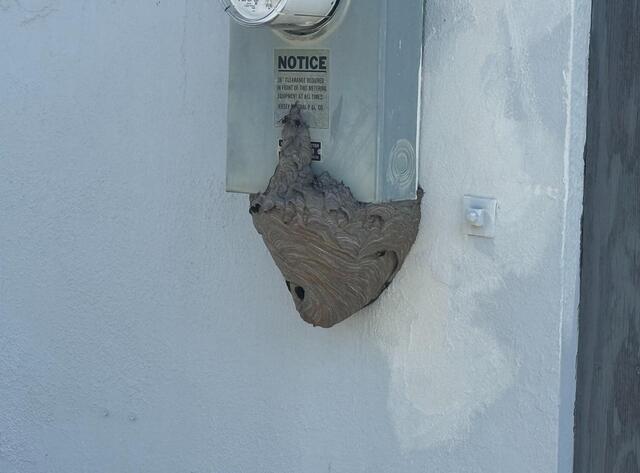Cowleys Pest Services Before & After Photos
Click on a photo to enlarge.
Bald-Faced Hornets Found Under Electrical Panel in Dayton, NJ
The maintenance team of this commercial property in Dayton, NJ were conducting a routine inspection of the building when they spotted a soccer-ball sized bald-faced hornets nest underneath the electrical panel. Since the property manager is a Home Protection Plan customer of Cowleys, he knew just who to call and we were sent out!
Since bald-faced hornets are known to be extremely territorial and aggressive, this nest needs to be removed immediately. To do so, we injected a knockdown aerosol application directly into the nest. This will rapidly neutralize the bald-faced hornets. After a few moments had passed, we removed the nest and disposed of it properly.
Taking Down the Paper Wasp Nest Before it Gets Bigger in Dayton, NJ
As we were servicing this property in Dayton, NJ we spotted a paper wasp nest at the peak of the home about 30 feet up. Paper wasps received their name from the paper-like material out of which they make their nests. They are semi-social stinging insects that usually have brown bodies with yellow or reddish markings. A sting from a paper wasp can be extremely painful and can cause allergic reactions in some people.
Using our ladder, we grabbed our extendable pole, attached an aerosol product to it, and liberally treated the nest. This product rapidly neutralizes the paper wasps. Moments later, we removed the nest, disposed of it, and applied a residual application to the area to prevent the paper wasps from returning and rebuilding their nest.
Raccoons wreak havoc in New Egypt attic
A Cowleys wildlife control team was dispatched to a home in New Egypt. This homeowner had a family of raccoons that had nested in his attic, apparently for quite a long time.
Fortunately, there was no longer an active infestation — the raccoons were long gone. However, the attic was a toxic mess from all their urine and droppings. While the pungent odor of animal waste wafting through your house is a problem, the real concern is the health hazard.
Cowleys wildlife control technicians are trained not only in trapping and excluding wildlife from homes and commercial buildings, but also in safely sanitizing and deodorizing those areas that have been infested.
Bat and Raccoons Removed & Attic Reinsulated in Milltown, NJ
This homeowner in Milltown, NJ had suffered through both a bat and raccoon infestation in his attic. Fortunately, our Little Rascals Nuisance Wildlife team were able to safely and successfully remove all the bats and raccoon from the attic and properly exclude them from the home. All that's left is to clean up and reinsulate the attic!
First, we carefully removed all of the contaminated insulation and then disinfected the entire attic. Next, we added TruSoft blown-in cellulose insulation, which will fill the attic to its recommended insulation levels. TruSoft blown-in cellulose insulation has a higher R-value than standard fiberglass insulation, has the highest Class-1 fire safety rating, is resistant to mold and pests, and is eco-friendly!
Pigeons make mess in Piscataway, NJ
A commercial facility in Piscataway used extensively by the public was having issues with pigeons nesting on a ledge above its elevators. The pigeons were causing problems because of their prodigious droppings in an enclosed area. Pigeons are one of the most common nuisance birds that we deal with regularly. Unfortunately, pigeons have no fear of being in close proximity to people, and their populations have exploded in cities and other high density areas where they enjoy a virtually unlimited food supply. Unfortunately, nuisance birds are like bad evicted tenants. They shuffle from building to building, and when they are “evicted” from one location with deterrent devices, they become someone else’s problem.
The situation here was unacceptable. Having pigeons circulating around in such an enclosed area was visually unappealing, noisy, bad smelling, as well as a potential health hazard from their toxic droppings. Something needed to be done, and done fast! A crew from Bird Solutions By Cowleys was called out to keep these nuisance birds from perching in the elevator area.
BirdSlide completely protects ledges against pigeons, swallows, and all other nuisance birds. It’s called BirdSlide for good reason. These angled barriers completely block ledges. Birds can’t grip them, and they slide right off. Birds, unlike kids, don’t find slides much fun. After trying to land a few times unsuccessfully, they get frustrated and look for another less hostile location.
BirdSlide works on any overhang-type structure where pigeons and other birds tend to congregate including ledges, eaves, angle irons, I-Beams, and most L-shaped ledges. Made from UV-stabilized polycarbonate, this deterrent is long-lasting and, best of all, it’s unobtrusive. After it is installed, it look like it’s part of the building. BirdSlide can even be color-matched to the building, if necessary for aesthetic reasons, in areas of high visibility. The product comes in grey or beige, but can be painted to match any color.









